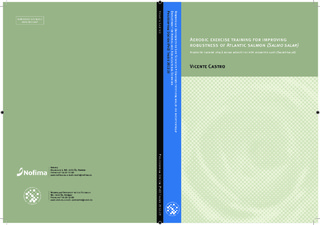| dc.description.abstract | Exercise training produces a wide range of benefits to fish kept in captivity. Research has shown that among several other parameters, growth, feed efficiency, feed intake and cardiac capacity are improved. In higher vertebrates, exercise training is known to improve performance in terms of resistance to infectious and life-style associated diseases. In fish, nevertheless, the latter has not been acknowledged so far. Despite this knowledge, and the high potential for increasing overall robustness of farmed fish species, regular aquaculture practices do not encourage swimming activity as a way to promote exercise training. Such a measure might become especially relevant in the actual fish farming industry scenario, where mortalities due to infectious diseases have maintained high for a long period of time and comprise a principal constrain to the sector’s sustainability. Production losses are particularly high the first months after sea-transfer, thus preventive health measures must be initiated in juvenile fish during the freshwater stage.
To assess the potential of exercise training for improving robustness of Atlantic salmon smolts, two experimental trials were performed, consisting of several training regimes differing in their duration, intensity and modality during the fresh water rearing stage. Robustness was measured in terms of growth, cardiac capacity and disease resistance.
The effects of exercise training on disease resistance were assessed by challenging the trained fish with Infectious Pancreatic Necrosis (IPN) after transfer to sea water (papers 1 and 2). It was found that exercise training at swimming velocities around one body length per second resulted in improved performance when compared to untrained fish. Furthermore, exercise training consisting on a daily change in swimming velocity (interval training) produced greater effects than continuous velocity training, though only when the velocity changes were mild. In the contrary, interval training regime with relatively large daily changes in water velocity, gave reduced disease resistance probably due to the formation of a stressful environment.
A step further in uncovering the effects of exercise training on resistance to infectious diseases was addressed in paper 2, as the inherent swimming capacity of fish within a population was taken into account. After splitting the population in two groups (poor and good) according to their swimming capacities, it was found that such inherent differences associated positively with disease resistance later in life. Furthermore, training conferred no disease resistance effects on the inherently good swimmers, while performance of poor swimmers was either improved through an optimal regime (achieving similar resistance level as good swimmers), or worsened through a deleterious regime.
To get an insight into the cardiac acclimation response to exercise training, the molecular mechanisms underlying this were studied in papers 1 and 3 through the use of gene expression (microarrays and real-time quantitative RT-PCR) and protein expression (western blot and immunohistochemistry) analyses. The selected tissue was the heart given its central role as a main exercise-target organ as well as its immunological relevance. In paper 1, exercise-induced improved survival to IPN was associated with a reduction in the expression of genes related to inflammatory mechanisms, including cytokines and enzymes producing eicosanoids. Further, exercise-induced disease resistance was linked to a consistent upregulation of complement components (immune effectors) as well as antioxidants and xenobiotics clearance molecules. This suggests that training modulates the cardiac molecular response, generating an immune competent tissue. In paper 3, the cardiac acclimation process was investigated for those cellular mechanisms known to strengthen the cardiac muscle in higher vertebrates. It was found that mRNA and protein levels of compounds participating in cardiac growth (both through cardiomyocyte hypertrophy and hyperplasia), contractility, blood supply and lipids metabolism were elevated by exercise training on an intensitydependent manner, resembling the molecular signature behind the mammalian exerciseinduced enlarged heart.
Finally, exercise training improved the growth rate of Atlantic salmon as seen in both experimental trials (papers 1 and 2). Such an effect was mainly ascribed to an increased feed intake (paper 1) and a mixture of feed intake and feed conversion efficiency (paper 2). Overall, this thesis demonstrates that exercise training Atlantic salmon pre-smolts has a strong potential for producing more robust fish, with improved disease resistance associated with a strengthened cardiovascular system and improved somatic growth. Future research with an emphasis on further optimizing the training regimes presented here will undoubtedly generate the required knowledge to implement protocols with the potential of bringing large benefits to the fish, the industry and the consumers. | nb_NO |

